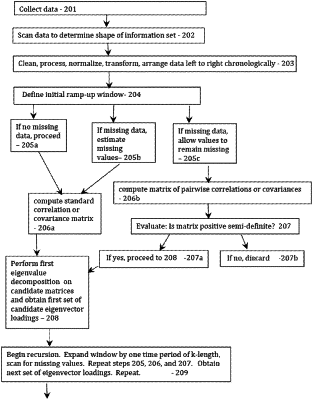| CPC G06Q 30/02 (2013.01) | 20 Claims |

|
1. A method for extracting a signal from a data set, the method comprising:
retrieving, by at least one processor, data from a plurality of data sources;
generating, by the at least one processor, a correlation matrix or a covariance matrix based on the retrieved data;
performing, by the at least one processor, an eigenvalue decomposition on the correlation matrix or the covariance matrix to determine a set of eigenvector loadings;
converting, by the at least one processor, a result of the eigenvalue decomposition into at least one indicator of a common signal among the retrieved data, wherein converting the result of the eigenvalue decomposition into the at least one indicator of the common signal comprises applying at least one loading from the set of eigenvector loadings as a weight to at least one corresponding observation in the retrieved data from the plurality of data sources; and
recursively repeating the retrieving, the generating, the performing, and the converting;
wherein the recursively repeating further comprises recursively generating an information set of the retrieved data from the plurality of data sources, wherein recursively generating the information set comprises determining a number of observations and a number of data sources available at each recursion and generating a first correlation matrix or covariance matrix based on the information set to begin a recursive eigenvalue decomposition, successively expanding the information set to include additional observations and data sources that may become available, in each recursion, and generating another correlation matrix or covariance matrix in each recursion based on the expanded information set.
|